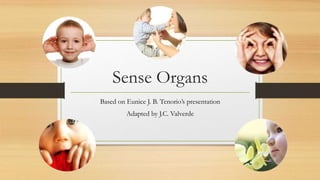
7th - Unit 1 - Sense Organs
- 1. Sense Organs Based on Eunice J. B. Tenorio’s presentation Adapted by J.C. Valverde
- 2. What are Sense Organs? • They are a part of your body, such as your eyes, nose, ears, skin, and tongue. • We use them to perceive the world around us.
- 3. Sense of Sight The eyes allow us to: • see and interpret new information • identify color • judge depth Fun fact: • There are people with different colored eyes.
- 4. Parts of the Eye • Cornea: the transparent window • Pupil: where light enters the eye • Iris: colorful part of the eye • Lens: helps focus images onto the retina • Sclera: eyeball’s outer coat
- 5. Parts of the Eye • Retina: changes the images into nerve signals. • Cones: there are 7 million color detecting cones • Rods: there are 120 million light detecting rods
- 6. Parts of the Eye • Retina: changes the images into nerve signals. • Macula: oval-shaped pigmented area near the center of the retina specialized in high resolution images • Optic Disk: optic nerve head • Optic Nerve: connects the eye to the brain
- 7. Sense of Smell The nose allows us to: • perceive scents • cleans the air we breathe • impacts the sound of our voice Fun fact: • The smell is connected to taste and memory.
- 8. Parts of the Nose • Nostril: each hole of the nose • Nasal Cavity: space behind the nose • Cilia: tiny hairs that pick up odor molecules in the air.
- 9. Parts of the Nose • Olfactory Bulb: receives neural input about odors • Hard Palate: Separates the nasal and oral cavities • Soft Palate: closes the nasal cavity from the oral cavity when swallowing
- 10. Sense of Hearing The ears allow us to: • listen to sounds • perceive vibrations Fun Fact: • The Inner Ear is also responsible of balancing the body.
- 11. Parts of the Ear • Ear Lobe/Outer Ear: collects sounds • Ear Canal: sound passes through it • Ear Drum: transforms sounds into vibrations
- 12. Parts of the Ear • Middle Ear: transports the vibrations to the Inner Ear • Inner Ear: transforms vibrations into signals for the brain
- 13. Sense of Taste The tongue allows us to: • perceive flavors • sense the temperature of things Fun Facts: • The tongue is one of the strongest muscles in the body. • If you close your nose, you won’t be able to taste.
- 14. Parts of the Tongue • The surface of the tongue is made up of about ten thousand taste buds. • Our taste buds detect only five chemical stimuli: sweet, bitter, sour, salty and umami (salts of certain acids that are associated with savory flavors). umami
- 15. Sense of Touch The skin allows us to: • perceive textures • feel temperature Fun Fact: • It is the largest sense organ because it is located around the entire body.
- 16. The Skin • The skin can: • sense cold, heat, contact, and pain with different kinds of receptors • feel if things are bumpy, rough, hard, soft, or smooth. • regulate temperature by sweating
- 17. The Skin • The skin can: • protect our body from bacteria and fungi
- 18. Summary The brain: • receives and interprets the information sent by the sense organs • takes decisions from the information gathered by these organs
- 19. SENSES sometimes you cannot trust them
